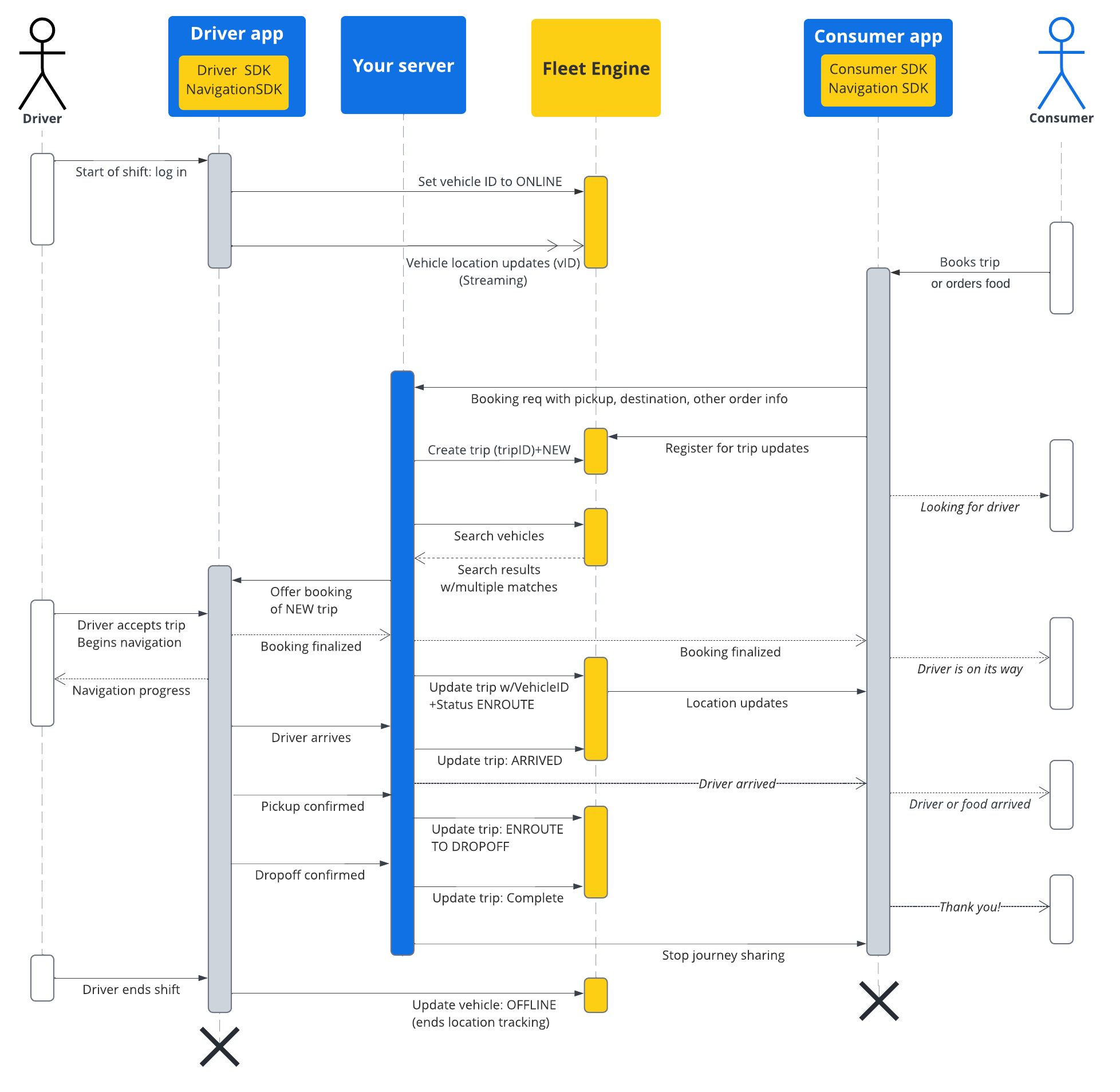במסמכי התיעוד שבקטע הזה מוסבר איך ליצור נסיעות ולעבוד איתן באמצעות שירות הנסיעות לפי דרישה של Google Maps Mobility. ההנחה היא שאתם מכירים את הנושאים הבאים:
- Fleet Engine: חשוב להכיר את פרטי ההטמעה של Fleet Engine, את מנגנוני הבקשות ואת האבטחה. לשם כך, אפשר לעיין במאמר מהו שירות Fleet Engine? ובנושאי האבטחה במאמר הגדרת Fleet Engine.
- היסודות של כלי רכב בשירותים לפי דרישה. מבוא לכלי רכב
- פרטים בסיסיים על הנסיעה בשירותים לפי דרישה. מידע על נסיעות על פי דרישה
ה-TripService שבו תשתמשו זמין ל-gRPC ול-REST.
כדי לפשט את העניינים, ההפניות לשדות הן בהתאם למוסכמות של gRPC.
ב-Fleet Engine לשירותים על פי דרישה, נסיעה היא סוג של מסלול שמדמה את תהליך אספקת משלוח מזון או בקשה לנסיעה מהצרכנים שלכם. לנסיעה יש סטטוס שאתם מדווחים עליו ל-Fleet Engine כשהנסיעה מתקדמת, כמו NEW, ENROUTE_TO_PICKUP ועוד. סטטוס הנסיעה תואם לנקודות ציון גיאוגרפיות שהוקצו לרכב, ו-Fleet Engine משנה את נקודות הציון האלה של הרכב בכל עדכון נסיעה שאתם מבצעים. מידע נוסף על נסיעות והקשר שלהן לכלי רכב זמין במאמר נסיעות על פי דרישה בנושא היסודות של Fleet Engine.
מחזור החיים של נסיעה
כדי לעקוב אחרי כל נסיעה ב-Fleet Engine, צריך קודם ליצור Tripישות. אפשר לעיין במאמרי העזרה בנושא gRPC או REST.
בטבלה הבאה מתוארת דוגמה לזרימה מקצה לקצה של נסיעה שנוצרה במערכת שלכם ושלבי מחזור החיים שלה ב-Fleet Engine. ההנחה היא שהגדרתם את Fleet Engine ויש לכם רכב להקצאה לנסיעה, ושהפעלתם את עדכוני המיקום באפליקציית הנהג. אפשר לעיין במאמר Driver SDK: On-demand trips.
| 1 | קבלת בקשה להזמנה. | לפני שנסיעה ב-Fleet Engine מתחילה, מערכת ההזמנות שלכם מקבלת קודם בקשה לנסיעה או למשלוח מלקוח דרך האפליקציה או דרך מערכת הזמנות אחרת. המערכת יוצרת את ישות הנסיעה באמצעות
CreateTrip עם שדות החובה, כמו מיקום האיסוף.
בשלב הזה אפשר גם להגדיר שדות אחרים, כמו נוסעים ומיקום הורדה, או להמתין עד להקצאת רכב. איך יוצרים נסיעה ליעד אחד |
| 2 | הקצאת רכב. | אתם יכולים להקצות כלי רכב לנסיעות ישירות במערכת שלכם ולדווח על ההקצאה ל-Fleet Engine, או להשתמש בשירות Search Vehicle כדי לחפש כלי רכב, לסנן לפי מאפייני הנסיעה וכלי הרכב כדי למצוא את כלי הרכב המתאים ביותר להשלמת הנסיעה. כל רכב אונליין שנמצא ברדיוס החיפוש שלכם משדר את המיקום שלו באמצעות עדכוני מיקום שמסופקים על ידי Driver SDK. אחרי ש- |
| 3 | עדכון הנסיעה | אחרי שהנהג מאשר את הנסיעה ומתחיל לנווט לנקודת האיסוף, המערכת מעדכנת את סטטוס הנסיעה מNEW לENROUTE_TO_PICKUP. אתם ממשיכים לשלוח בקשות למיקום הרכב לאורך הנסיעה, או דרך חיבור ישיר מהאפליקציה אל השרת העורפי שלכם, או על ידי שליחת בקשות ל-Fleet Engine, שמקבל זרם מתמשך של עדכוני מיקום הרכב מ-Driver SDK. לאחר מכן, המערכת שלכם מדווחת על כל אבן דרך בנסיעה ל-Fleet Engine, שמעדכן את רשימת נקודות הדרך של הרכב בהתאם.
|
| 4 | שיתוף המסלול עם הלקוח. | Fleet Engine מעביר את פרטי הנסיעה ואת מיקום הרכב אל Consumer SDK, שמשתמש ב-listener כדי לקבל עדכונים על הנסיעה ולהציג אותם באפליקציה לצרכן. מערכת Fleet Engine מעדכנת באופן אוטומטי את זמן ההגעה המשוער, את המרחק שנותר, את המסלולים ואת נקודות הדרך שנותרו לרכב. מידע נוסף זמין במאמר שיתוף נסיעות בהזמנה. |
| 5 | סיום הנסיעה. | אחרי שהרכב מגיע לנקודת הביניים של היעד בנסיעה והנהג מציין שהנסיעה הסתיימה בהצלחה, המערכת מגדירה את TripStatus ל-COMPLETE ב-Fleet Engine. חשוב לזכור: כמו כלי רכב, ישויות של נסיעות נשארות פעילות ב-Fleet Engine למשך 7 ימים, ללא קשר לסטטוס שלהן, ואז הן מוסרות. |
תהליך רצף הנסיעות
בתרשים הבא מוצג תהליך מפורט יותר.


